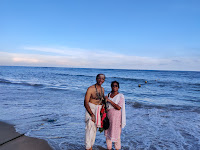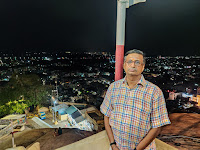Day 9
In the morning, we finished our ablutions and
left for Pazhani (another of the 6 most important temples dedicated to Lord
Muruga). The drive was smooth through well maintained highways, and we reached
by around 10 a.m. The weather was pleasant – neither too hot nor cold. After
breakfast at a restaurant located near the steps leading to the temple, we reached
the main entry point to climb the hill. The temple, built around 2nd
& 5th Century CE by the Cheraas, is located on the top of the
Hill. One must climb 400 odd steps to reach the temple of Lord Muruga (known
here as Dhandayuthapani).
 |
| Lord Dhandayuthaapani |
As per Hindu mythology, this hillock was
carried from Mount Kailas by Idumban (one of the devotees of Lord Muruga and a
guardian of His temples) under the orders of Sage Agasthaya. Once Sage Narada visited
Kailas and presented the Gynana-pazham (fruit of knowledge) to Lord Shiva who
in turn announced that He will award it to whichever of His two sons who first
circumambulates the whole world thrice. Lord Muruga, eager to win the prize,
immediately climbed on His mount (The Peacock) and set out on the journey. His
brother Lord Ganesh, who had the slow moving Mouse as his mount, introspected
and decided that the whole world is within His parents (Lord Shiva and Parvati)
and therefore, went around them thrice thereby winning the fruit of knowledge.
Muruga, who is the presiding deity over the planet of action Mars, felt upset
over this and chose to leave His home and reside in the Pazhani hilltop as a
hermit and continues to live there even today. The idol of Muruga here is made
out of nine herbs (known as Navapashanam) and is believed to have been
consecrated by a Siddha purusha called as Sage Bogar. The idol is unique and
beautiful where an emanciated Lord Muruga stands alone with a stick in His
right hand, as is carried by ascetics. The idol has properties of curing most
deadly of ailments if one consumes the abhishekam theertham.
Instead of climbing the steps, we decided to
take the elephant route which does not have many steps. It is more of a gradual
ascent. The route to the temple was scenic as we could get the glimpse of the
town from the elevation. We could not take any pictures as cameras / mobile
phones are forbidden to be taken up to the temple. After we reached the temple,
we got special VIP ticket and, after a short wait, we were escorted directly to
the sanctum. We sat there and witnessed the abhishekam of the Lord which was a
very emotional moment for all of us. To see this form of the deity bereft of
any alankaram is a blessing indeed and it will forever be etched in our minds.
 |
| Tiruparangundram |
After darshan, we came out and I did my
afternoon prayers outside the temple. After this we descended and reached down
by around 1 p.m. We had some coconut water to quench our thirst as it was very
warm by then. We then went to another Murugan temple in the town below. This is the Thiruaavinankudi temple which was in existence even before the temple came up on the hill. Besides Murugan, this temple also has shrines for Ganesh, Shiva, Parvati and Shaneeshwara. People generally visit this temple first before climbing the hill. After a
quick darshan here, we visited a shop to look for some items to purchase as a
memory of this visit. However, we did not buy anything. After reaching Madurai
by afternoon, we had had lunch at a North Indian restaurant called Bhagawati
Mohans Bhojanalay before proceeding back to our hotel. The food here was
excellent and low priced. It was a welcome change to eat North Indian Thali
after many days of eating South Indian stuff. We were quite bored of eating
dosa / idli / Pongal every day..
 |
| Tiruparangundram Temple |
After some rest at the hotel and finishing our evening prayers, we visited the last of the 6 important temples of Lord Muruga called Tiruparangundram. This is located within 8 kms from Madurai city itself. This is believed to be the first Houses of Lord Muruga and was built by the Pandyas dynasty in the 6th century CE. As per Skand Purana, after Lord Muruga killed the demon known as Surapadman at Thiruchendur, He married His consort Devasena (daughter of Lord Indra) here. Lord Muruga is believed to have worshipped His father Lord Shiva here as Parangirinathar. The temple is located and carved out of a rocky hill and is very different from other temples. The whole temple is built inside the rocky mountain and is very warm during day time. The other deities in this temple include Shiva, Vishnu, Ganesh and Durga.
As it was raining in the evening there were
very few people at this temple. We could get a comfortable darshan here without
waiting in any queue. After this we
drove back to the same restaurant (Gowri Shankar) for dinner and returned to
our hotel in the night.
Day 10
The last day of our yatra was also very
auspicious. Early in the morning around 6 a.m., we visited the world renowned Madurai
Meenakshi temple. It was drizzling in the morning and we got drenched as we had
to walk a couple of hundred meters from the drop off point to reach the temple.
As arranged by us, we were met at the temple by a priest who is based out of Malaysia but who comes many times each year to this temple. He was kind enough
to escort us to the sanctum where we got a darshan without having to wait. He
also took us to the Sundareshwarar temple situated within the same premises for
a darshan of Lord Shiva. We had excellent darshan at the two temples and then
returned to our hotel after having breakfast at Gowri Shankar. Later in the
afternoon, we had lunch at Bhagawathy Mohans Bhojanalay where we had lunch the
previous day. Then we returned to our hotel for some rest.
In the evening, we checked out of our hotel
and proceeded to the airport for our flight back home. The flights were delayed
due to unseasonal rains in many parts of India. We were provided with light
snacks by the airline due to the delay. After a delay of around 3 hours, we
boarded our flight and reached Mumbai late in the night. After this, we
returned home in an Uber ending our long blessed yatra during which we covered the six abodes of Lord Muruga, the nine abodes of the Navagraha temples plus many important temples of Tamil Nadu and could also complete out Tula Kaveri snanam.
Hope you enjoyed reading this blog and will be happy to provide any information / help to any of you who want to plan a yatra to any of the places covered by us.




























